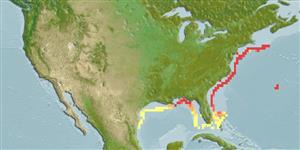Environment: milieu / climate zone / depth range / distribution range
Ecología
marino demersal; rango de profundidad 106 - 154 m (Ref. 86730). Subtropical; 41°N - 24°N
Western Atlantic: New Jersey to southern Florida in the USA; more northern records are based on misidentifications. Northwest Atlantic: Canada (Ref. 5951).
Tamaño / Peso / Age
Maturity: Lm ? range ? - ? cm
Max length : 46.7 cm TL macho / no sexado; (Ref. 40865)
Inhabits offshore water (Ref. 7251). Males mature at 19.7 cm TL and females gravid at 22.7 cm TL (Ref. 40865).
Life cycle and mating behavior
Maturities | Reproducción | Spawnings | Egg(s) | Fecundities | Larva
Robins, C.R. and G.C. Ray, 1986. A field guide to Atlantic coast fishes of North America. Houghton Mifflin Company, Boston, U.S.A. 354 p. (Ref. 7251)
IUCN Red List Status (Ref. 130435)
Threat to humans
Harmless
Human uses
Pesquerías: sin interés
Herramientas
Special reports
Download XML
Fuentes de Internet
Estimates based on models
Preferred temperature (Ref.
123201): 11.5 - 22.2, mean 18 °C (based on 9 cells).
Phylogenetic diversity index (Ref.
82804): PD
50 = 0.5000 [Uniqueness, from 0.5 = low to 2.0 = high].
Bayesian length-weight: a=0.00089 (0.00039 - 0.00204), b=3.00 (2.80 - 3.20), in cm total length, based on LWR estimates for this (Sub)family-body shape (Ref.
93245).
Nivel trófico (Ref.
69278): 3.4 ±0.0 se; based on diet studies.
Resiliencia (Ref.
120179): Alto, población duplicada en un tiempo mínimo inferior a 15 meses (Preliminary K or Fecundity.).
Fishing Vulnerability (Ref.
59153): Moderate vulnerability (37 of 100).
